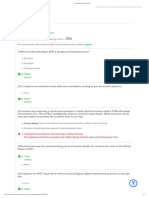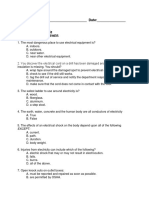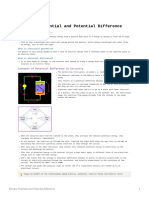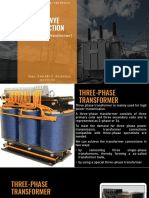Electrical Safety Quiz 2018 KEY
Electrical Safety Quiz 2018 KEY
Uploaded by
MeowwwewCopyright:
Available Formats
Electrical Safety Quiz 2018 KEY
Electrical Safety Quiz 2018 KEY
Uploaded by
MeowwwewOriginal Description:
Original Title
Copyright
Available Formats
Share this document
Did you find this document useful?
Is this content inappropriate?
Copyright:
Available Formats
Electrical Safety Quiz 2018 KEY
Electrical Safety Quiz 2018 KEY
Uploaded by
MeowwwewCopyright:
Available Formats
PLUMBING SHEETMETAL PROCESS PIPING SERVICE AND MAINTENANCE
FIRE SPRINKLERS SYSTEMS MILLWRIGHT ELECTRICAL DATA TECHNOLOGY
Safety Quiz: Electrical Safety Quiz
GFCI and MCC Authorized
Name: TEST KEY
Instructor:
Date:
1. When talking about electrical safety, there are 3 categories of workers:
___QUALIFIED___________, ______AUTHORIZED__________, ____UNAUTHORIZED_____________
2. Authorized persons can enter Motor Control Centers (MCC) to perform the following tasks:
a. Inspections
b. Observations
c. Lockout/Tagout verification
d. Use the phone
e. Reset of an overloaded 110V outlet
f. All of the above
3. The primary hazards that may be encountered while working with electricity are:
a. Arc flash
b. Electrical shock
c. Arc blast
d. All of the above
4. Shock can occur when a person contacts:
a. Both wires of an energized circuit
b. One wire of an energized circuit and the ground
c. A metallic part in contact with an energized wire while the person is also in contact with the ground
d. Sticks their tongue in an outlet
e. All of the above
5. Potential causes of an arc flash include:
a. Workers mistakenly dropping tools on live parts
b. Pests entering switchgear through openings
c. Faulty operation of a load break switch
d. Dust or moisture accumulating to weaken air insulated bus bars
e. Improper use of test equipment
f. All of the above.
6. The most common electrical hazard at construction sites is:
a. Staples in extension cords
b. Changing fuses
c. Ground fault electrical shock
d. Lightning
7. Electrical shock can result in:
a. A stopped heart
b. Severe burns
c. Both a. and b
d. None of the above
November 2018 Page 1 of 4
PLUMBING SHEETMETAL PROCESS PIPING SERVICE AND MAINTENANCE
FIRE SPRINKLERS SYSTEMS MILLWRIGHT ELECTRICAL DATA TECHNOLOGY
8. Electricity always follows the easiest path to ___________ even if that path is through a human body
a. Complete the circuit
b. Ground
c. Its source
d. Its conductor
9. Electrical safety work practices include:
a. The use of ground-fault circuit interrupters
b. Verifying power is OFF before doing repairs
c. Keeping proper distances from overhead power lines
d. All of the above
10. Workers and equipment should have a minimum clearance of ______ feet between energized 50 kv overhead
power lines and themselves.
a. 14
b. 25
c. 10
d. 20
11. Conductive articles of jewelry and clothing may be worn around exposed energized parts.
a. True
b. False
12. An arc flash is:
a. A high-pressure sound wave
b. A short circuit that results in an ionized air fireball with temperatures up to 35,000 °F
c. An electrical fire
d. The unit of electrical power
13. The effects of an Arc Flash/Blast include extremely high temperatures, tremendous pressure and shrapnel that
could seriously injure or fatally injure employees in the area.
a. True
b. False
14. The Flash Protection Boundary is the distance from exposed live parts that prevents a second-degree burn:
a. True
b. False
15. The Limited Approach Boundary or the Flash Protection Boundary is marked with red danger tape zone. Permission
must be granted from the qualified person in control of that boundary before an authorized person can cross while
being escorted.
a. True
b. False
16. Hazard / Risk Category (HRC) information is located:
a. On a warning label, directly on the electrical equipment
b. In your supervisor’s office
c. In a binder in the area of the equipment
d. A and C
e. All of the above
17. PPE required in a MCC room to perform a housekeeping task or verify lockout includes:
a. Arc flash shield
b. Safety glasses, hard hat and work boots
c. Chemical suit with purple galoshes
d. All of the above
November 2018 Page 2 of 4
PLUMBING SHEETMETAL PROCESS PIPING SERVICE AND MAINTENANCE
FIRE SPRINKLERS SYSTEMS MILLWRIGHT ELECTRICAL DATA TECHNOLOGY
18. Which of the following is NOT appropriate PPE to wear when entering an MCC room to perform a LOTO (lockout
tagout):
a. Standard PPE issue (Safety glasses, hard hat and work boots)
b. Winter jacket made of synthetic materials (non-cotton)
c. All-natural fiber clothing (cotton)
d. Additional PPE as required by the Hazard / Risk Category (HRC)
19. Understanding the Hazard / Risk Category (HRC) associated with a piece of equipment will determine the PPE
requirements for doing electrical work on that equipment.
a. True
b. False
20. An Authorized Person may work within the restricted and prohibited approach boundaries.
a. True
b. False
21. An Authorized Person must stay outside the barricade placed at the flash protection or limited approach boundary
(whichever is greater) unless escorted by a Qualified Person.
a. True
b. False
22. A Ground-Fault Circuit Interrupter (GFCI) is:
a. Designed to prevent electrical shock to the user
b. Required by Winger policy when using power tools
c. Required to be tested daily before use
d. Required to be taken out of service if defective
e. Designed to trip at 5 milliamps
f. All of the above (maybe, most likely, ok all)
23. GFCI’s (Ground Fault Circuit Interrupters) should be used in the following locations:
a. Locations exposed to weather
b. Wet environments
c. Outdoor receptacles
d. Underground installations
e. A thru C only
f. All of the above
24. What should we do before using any electrical equipment, power tool or extension cord?
a. Perform a pre-use inspection looking for integrity of plug-in and outlet, pinched or damaged outer jacket,
damaged insulation
b. Test the GFCI to make sure it is working properly
c. Immediately tag defective equipment and return to tool crib or shop for repair or replacement
d. All of the above
25. When you discover power tools or extension cords with missing ground prongs, damaged plugs, nicks, cuts, and/or
scrapes, you should:
a. Take the defective tool or cord out of service immediately.
b. Wear insulated gloves when using the tool or cord.
c. Use electrician’s tape to insulate yourself from the energized parts.
d. Repair the defective tool or cord with a vulcanization kit.
e. Let it be, it’s the next person’s problem
26. It is acceptable to use electrical tape to repair a frayed power cord, or splice a power cord, as long as you cover
all exposed wire.
a. True
b. False
November 2018 Page 3 of 4
PLUMBING SHEETMETAL PROCESS PIPING SERVICE AND MAINTENANCE
FIRE SPRINKLERS SYSTEMS MILLWRIGHT ELECTRICAL DATA TECHNOLOGY
27. Power tools should be equipped with a ground 3-prong plug unless clearly marked as “double-insulated” by the
manufacturer.
a. True
b. False
28. What is the purpose of the third prong on a 3-prong plug?
a. It provides a path to ground for electricity that may stray from a tool, cord or appliance.
b. It provides extra power for equipment requiring high wattage.
c. It helps hold the plug firmly in the outlet.
d. It makes people ask stupid questions.
29. When using portable electric equipment, you should do all of the following except:
a. Remove the ground pin on the plug so the plug matches the two-prong receptacle
b. Use adaptors which do not affect the equipment grounding connections
c. Remove from service equipment with deformed plugs.
d. Use dry hands to plug and unplug equipment.
30. Extension cords can get hot enough to melt when:
a. The gauge of wire is not heavy enough for the amount of current flowing through them.
b. They are used for tasks beyond their rated ability.
c. Both a and b.
d. None of the above.
31. When routing extension cords overhead remember to:
a. Keep out of walkways
b. Never tie up extension cords with wire
c. Route over doorways or walkways at least 7 feet high or thru installed Knappco doors
d. All of the above
November 2018 Page 4 of 4
You might also like
- SIFANG - CSC-326G - V1.00 - Numerical Transformer Protection Equipment Technical Manual - 2012-02Document54 pagesSIFANG - CSC-326G - V1.00 - Numerical Transformer Protection Equipment Technical Manual - 2012-02MarkusKunNo ratings yet
- Basic Electrical Safety QuizDocument2 pagesBasic Electrical Safety QuizSaber AbdelaalNo ratings yet
- 14.electrical SafetyDocument30 pages14.electrical SafetyZulkarnaenUchihaNo ratings yet
- What Is Electrical Safety?Document32 pagesWhat Is Electrical Safety?Zaheed Manoo100% (1)
- Electrical Safety PPT FinalDocument50 pagesElectrical Safety PPT FinalKK100% (1)
- Fall Protection Quiz AnswersDocument4 pagesFall Protection Quiz AnswersIrfanNo ratings yet
- Electrical Safety PresentationDocument19 pagesElectrical Safety PresentationMutahirrasool100% (2)
- Electrical SafetyDocument44 pagesElectrical Safetytkc47100% (2)
- Electrical Safety QuizDocument2 pagesElectrical Safety QuizRehman MuzaffarNo ratings yet
- Earthing, Safety Precaution and MaintenanceDocument62 pagesEarthing, Safety Precaution and MaintenanceavinashsarwadeNo ratings yet
- Electrical Safety (EN) PDFDocument17 pagesElectrical Safety (EN) PDFmd100% (1)
- Electrical HazardsDocument56 pagesElectrical HazardsBryan PiguaveNo ratings yet
- Safety Quiz - Electrical Safety-1: DirectionsDocument2 pagesSafety Quiz - Electrical Safety-1: Directionsshreyas50% (2)
- Electrical Safety in Industry & Home-11-12-08Document18 pagesElectrical Safety in Industry & Home-11-12-08narasimhamurthy414100% (1)
- Safety in Engineering IndustryDocument6 pagesSafety in Engineering IndustryJaved KhanNo ratings yet
- Avoiding Electrocution HazardsDocument11 pagesAvoiding Electrocution HazardsJojolasNo ratings yet
- Quiz On Electrical SafetyDocument1 pageQuiz On Electrical SafetySarojini Veeraraghavan100% (2)
- Basic Electrical Safety Module 1Document39 pagesBasic Electrical Safety Module 1malawi200No ratings yet
- Electrical Safety PDFDocument16 pagesElectrical Safety PDFARPITA KUMARINo ratings yet
- NR 10 - General Electrical Safety and Hazard RecognitionDocument51 pagesNR 10 - General Electrical Safety and Hazard RecognitionCPSSTNo ratings yet
- Electrical HazardsDocument56 pagesElectrical HazardsZainorin AliNo ratings yet
- Hse Sample Examination Questions: DisclaimerDocument18 pagesHse Sample Examination Questions: DisclaimerAkwayamai PhilipNo ratings yet
- 19 Tool Box MeetingDocument11 pages19 Tool Box Meetingyelsa otreblaNo ratings yet
- Electrical Safety Based Questions and AnswersDocument2 pagesElectrical Safety Based Questions and AnswersDijith Jhansi100% (1)
- Safety Instrumentation Lecture - 1: DR V S Krushnasamy Associate ProfessorDocument160 pagesSafety Instrumentation Lecture - 1: DR V S Krushnasamy Associate Professorkrushnasamy subramaniyan100% (1)
- Safety Quiz - Electrical Answer KeyDocument2 pagesSafety Quiz - Electrical Answer KeyDhaneswar Swain100% (1)
- Scaffolding Erection &dismanlting JSADocument7 pagesScaffolding Erection &dismanlting JSAShahid Bhatti100% (1)
- Chapter 7 - Electrical SafetyDocument67 pagesChapter 7 - Electrical SafetyAhmad Firdaus Zawawil AnwarNo ratings yet
- Mechanical Hazard Material HandlingDocument90 pagesMechanical Hazard Material HandlingNeoNo ratings yet
- Electrical Safety QuizDocument43 pagesElectrical Safety Quizjaved.saeed2024No ratings yet
- Hand and Power Tool Safety 08Document60 pagesHand and Power Tool Safety 08galihNo ratings yet
- GEN HIRADeCDocument15 pagesGEN HIRADeCPower MuruganNo ratings yet
- Evolution of Modern Safety ConceptsDocument16 pagesEvolution of Modern Safety ConceptsMuhammad Arif0% (1)
- Personal Protective EquipmentDocument36 pagesPersonal Protective Equipmentaqsa imranNo ratings yet
- Fire Hydrant QuestionsDocument1 pageFire Hydrant QuestionsAhmed Mohamed GadoNo ratings yet
- Safety HSE ManagementDocument167 pagesSafety HSE ManagementMazen FakhefakhNo ratings yet
- Behavior-Based SafetyDocument22 pagesBehavior-Based SafetyAnthony Van Tejano SacabinNo ratings yet
- Safety Quiz - Lockout Tagout Answer KeyDocument3 pagesSafety Quiz - Lockout Tagout Answer KeyrajkumarveluNo ratings yet
- SOP 17 - Idler & Pulley Cleaning ActivityDocument6 pagesSOP 17 - Idler & Pulley Cleaning Activityfaraz ahmedNo ratings yet
- Work at Height Training Module: Safety FirstDocument15 pagesWork at Height Training Module: Safety FirstMiguel Gonzales100% (3)
- 01-02 Module 6 Workplace Emergency PreparednessDocument27 pages01-02 Module 6 Workplace Emergency PreparednessBryan ArabitNo ratings yet
- Industrail Safety: Sixth Semester B E June/July 2018Document55 pagesIndustrail Safety: Sixth Semester B E June/July 2018Priyadarshi MNo ratings yet
- Electrical HazardsDocument13 pagesElectrical HazardsKent FerraroNo ratings yet
- Maintenance of Hand and Power Tools Procedure (VET)Document6 pagesMaintenance of Hand and Power Tools Procedure (VET)taufikNo ratings yet
- Industrial Safety Assignment TopicsDocument2 pagesIndustrial Safety Assignment TopicsDilip Patel100% (2)
- Machine Guarding QuizDocument4 pagesMachine Guarding QuizVanessa EspinoNo ratings yet
- Genral Risk Assesment 15.8.2023Document57 pagesGenral Risk Assesment 15.8.2023sohaibNo ratings yet
- Safety Assesnent QuestionsDocument11 pagesSafety Assesnent Questionssoumyaranjan38No ratings yet
- Electrical SafetyDocument28 pagesElectrical SafetynagarajanNo ratings yet
- 4) Arc Welding EquipmentsDocument6 pages4) Arc Welding EquipmentsKrako TramNo ratings yet
- Chapter 14 MECHANICAL HAZARDSDocument25 pagesChapter 14 MECHANICAL HAZARDSJonathan TungalNo ratings yet
- Electrical Safety Quiz PSSDocument2 pagesElectrical Safety Quiz PSSRaphael GacramaNo ratings yet
- Test in The Safety PDFDocument35 pagesTest in The Safety PDFJaber Al JafarNo ratings yet
- 10 Questions For Electrical Safety PDFDocument2 pages10 Questions For Electrical Safety PDFdilesh0% (1)
- Electrical SafetyDocument2 pagesElectrical Safetysakthi service EngrNo ratings yet
- QUIZDocument4 pagesQUIZJudi Normae JoanneNo ratings yet
- 6189 L3u305 Sample Questions 3Document3 pages6189 L3u305 Sample Questions 3mwood1scNo ratings yet
- Electrical TestDocument3 pagesElectrical TestAbel ThomasNo ratings yet
- Electrical Safety Multiple Choice QuestionsDocument13 pagesElectrical Safety Multiple Choice Questionsriddhibansal7102No ratings yet
- 5 Electricity Test AnswersDocument4 pages5 Electricity Test AnswersnajehNo ratings yet
- 1082.21.b Body Boiler TH.V 1250 1.250.000kcal.h 1.453 KW Quemadores Chile S.P.ADocument13 pages1082.21.b Body Boiler TH.V 1250 1.250.000kcal.h 1.453 KW Quemadores Chile S.P.Acristian villegasNo ratings yet
- 300 SQMM For 330kw Wattpower InverterDocument1 page300 SQMM For 330kw Wattpower Inverterharikrushan.patelNo ratings yet
- GL1800 FI CodesDocument6 pagesGL1800 FI CodesddbianuNo ratings yet
- Stock Management With Profit & LossDocument1 pageStock Management With Profit & Losspradipbarman001990No ratings yet
- Effect of Clearance On Volumetric Efficiency in 2D Piston PumpsDocument12 pagesEffect of Clearance On Volumetric Efficiency in 2D Piston PumpsSiddharth SinghNo ratings yet
- Storage Tank: Standard Drawing FORDocument25 pagesStorage Tank: Standard Drawing FORHamid Mansouri100% (1)
- SC Fire Resistant Catalogue 2020Document16 pagesSC Fire Resistant Catalogue 2020Phua Shang YangNo ratings yet
- Transmission Line Arresters Application For Control of SOV On 500kV TLDocument5 pagesTransmission Line Arresters Application For Control of SOV On 500kV TLaishe8No ratings yet
- 11.guarded Plate ApparatusDocument4 pages11.guarded Plate ApparatusManoj Kumar.SNo ratings yet
- Ic-Mid Exam N SolutnDocument9 pagesIc-Mid Exam N SolutnFasilNo ratings yet
- Topic-Griha Building: Sub - Environmental Responsive DesignDocument6 pagesTopic-Griha Building: Sub - Environmental Responsive DesignGowri PriyaNo ratings yet
- Caranto Bayrante Lagmay-LibreDocument6 pagesCaranto Bayrante Lagmay-LibreMuhammad IkhwanNo ratings yet
- SOTEX Cleanomat Pro Automatic Filter UnitsDocument1 pageSOTEX Cleanomat Pro Automatic Filter Unitssrimech5121No ratings yet
- E20 Green Fuel - Single Line Diagram (22.02.22)Document1 pageE20 Green Fuel - Single Line Diagram (22.02.22)SIL PROJECTSNo ratings yet
- AtomistructurenewDocument62 pagesAtomistructurenewetiosamiNo ratings yet
- Analysis of Drilling Fluid Rheology & Pressure DropDocument66 pagesAnalysis of Drilling Fluid Rheology & Pressure Dropgroulx.renNo ratings yet
- 08 - Electric - Potential - and - Potential - DifferenceDocument3 pages08 - Electric - Potential - and - Potential - Differencechie CNo ratings yet
- Wye-Wye Connection of A Three Phase TransformerDocument12 pagesWye-Wye Connection of A Three Phase TransformerDevee AmbasNo ratings yet
- 115 PPT Electrostatics Origin Electrostatics CapacitanceDocument67 pages115 PPT Electrostatics Origin Electrostatics CapacitanceErojo, Kyeane Red N.No ratings yet
- Various Forms of EnergyDocument2 pagesVarious Forms of EnergyRhianna TetlowNo ratings yet
- Speaking - Course 1Document3 pagesSpeaking - Course 1trinhthuha090125No ratings yet
- Permintaan Material Pemk Camelia-001Document20 pagesPermintaan Material Pemk Camelia-001mjs dedekNo ratings yet
- Presentation On: Electric CarDocument15 pagesPresentation On: Electric CarrohitpowariNo ratings yet
- Bauer Evaporative Condenser ManualDocument14 pagesBauer Evaporative Condenser Manualjcastell100No ratings yet
- Foreign Going Ships With Bangladesh Flag: Owner IMODocument2 pagesForeign Going Ships With Bangladesh Flag: Owner IMOmdsifat425No ratings yet
- Design of Front-End Push-Pull Sine Wave Inverter: IOP Conference Series: Earth and Environmental ScienceDocument8 pagesDesign of Front-End Push-Pull Sine Wave Inverter: IOP Conference Series: Earth and Environmental SciencePABLO MAURONo ratings yet
- Catalog Bbs2fr 25Document1 pageCatalog Bbs2fr 25SYARULNIZAM ROSLANNo ratings yet
- PHCbi Refrigerators MPRS163 MPRS313Document2 pagesPHCbi Refrigerators MPRS163 MPRS313Eslam HassanNo ratings yet
- Elmendorf Tearing TesterDocument3 pagesElmendorf Tearing TesterTaofiqur Rahman ShochchoNo ratings yet
- Breathtaking Residential Building in Mexico Comes With Its Own Vertical Forest and Solar Panels On Its Terrace - Yanko DesignDocument8 pagesBreathtaking Residential Building in Mexico Comes With Its Own Vertical Forest and Solar Panels On Its Terrace - Yanko DesignDiego ChicaNo ratings yet

























































































